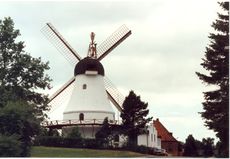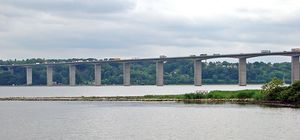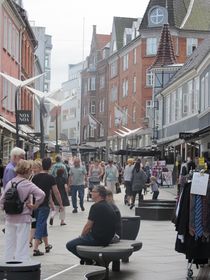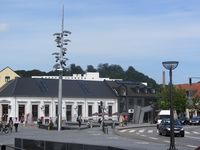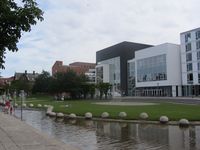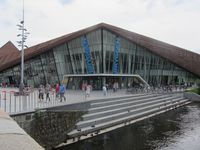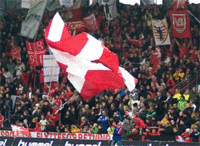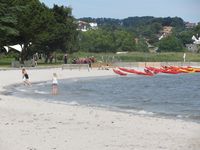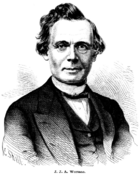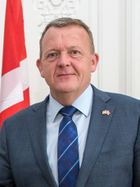ڤايلى
ڤايلى
Vejle | |
|---|---|
بلدة | |
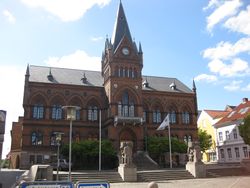 Vejle Town Hall | |
| الإحداثيات: 55°43′N 9°32′E / 55.717°N 9.533°E | |
| البلد | |
| المنطقة | جنوب الدنمارك (Syddanmark) |
| البلدية | ڤايلى |
| First mentioned | 1256 |
| Municipal charter | 1327 |
| الحكومة | |
| • Mayor | Jens Ejner Christensen (V) |
| المساحة | |
| • الإجمالي | 144 كم² (56 ميل²) |
| • Municipality | 1٬066٫32 كم² (411٫71 ميل²) |
| المنسوب | 8 m (26 ft) |
| التعداد (1 January 2016)[1] | |
| • الإجمالي | 57٬051 |
| • الكثافة | 400/km2 (1٬000/sq mi) |
| • Municipal | 111٬743 |
| منطقة التوقيت | UTC+1 (CET) |
| • الصيف (التوقيت الصيفي) | UTC+2 (CEST) |
| Postal code | 7100 |
| مفتاح الهاتف | (+45) 7 |
| الموقع الإلكتروني | www.vejle.dk |
ڤايلى (Vejle ؛ النطق الدنماركي: [ˈvaɪ̯lə]) هي بلدة في جنوب الدنمارك، في جنوب شرق شبه جزيرة يوتلاند على رأس فيورد ڤايلى، حيث يلتقي نهر ڤايلى و نهر گرايس ووادياهما. وهي مقر مجالس بلدية ڤايلى (كومونه) ومنطقة جنوب الدنمارك. ويبلغ عدد سكان المدينة 57,051 نسمة (اعتبارا من 1 يناير 2019[تحديث]),[1] مما يجعلها تاسع أكبر مدينة في الدنمارك. بلدية ڤايلى يبلغ تعدادها 111,743 نسمة (اعتبارا من 2016[تحديث]).[1] المدينة هي جزء من منطقة المثلث، التي تضم الجارتين كولدنگ و فردرتسا.
أكثر ما تشتهر به ڤايلى هو رباها المغطاة بالغابات، الفيورد والميناء والتسوق والممشى والطاحونة.
التاريخ
The word "Vejle" derives from the Old Danish word wæthel, meaning "ford" or "wading place" due to its location at a busy crossing over Vejle River. During Viking times, the wetlands around Vejle had to be crossed at the Ravning Bridge, a nearly half-mile wooden boardwalk. The first recorded mention of the town is from 1256, and the first known merchant town privileges were issued by King Valdemar III in 1327.
Archaeological digs near St. Nicolai Church in downtown Vejle have shown that there were residences in the area as far back as 1100. The king's castle, Castrum Wæthel, was located where Vejle Trafikcenter is today.
During the Middle Ages, Vejle was important as a market town, and developed along those lines up to the mid-17th century, trading with cities such as Lübeck and Flensburg, in what is now Germany.
In the late 17th and early 18th centuries, Vejle's population was diminished as a consequence of plague and war. In 1796, though, Vejle was made the seat of the newly founded Vejle County, and the town expanded throughout the 19th century, benefiting from improvements such as a new harbour on the fjord, a railroad station, and modern utilities.
From the mid-19th century into the 20th century, Vejle developed from a provincial market town into a busy industrial centre, eventually becoming known as the "Manchester of Denmark" for its many cotton mills.[2]
الجغرافيا
Downtown Vejle was built on an island of glacial till in Vejle River remaining from a hill formed during the last ice age.[3]
For a country where the highest natural elevation is only about 170 m (558 ft) above sea level, Vejle is known for the forested hills that rise to the north and south of the town and fjord.
The valleys of the two rivers that converge at Vejle are both unique in Denmark: Vejle River Valley (Vejle Ådal) is the longest tunnel valley in Denmark, and the Grejs Valley (Grejsdalen) is the largest ravine in Denmark.
Both empty into Vejle Fjord, which connects Vejle by water through the Little Belt strait to the Baltic Sea, and through the Kattegat and Skagerrak straits to the Atlantic Ocean.
الأحياء السكنية
Many of Vejle's neighbourhoods began as separate towns or villages that merged with the city as it grew. Søndermarken, Nørremarken, and Grejsdalen, however, were all founded as extensions of the city onto the surrounding hillsides.
Vejle's neighbourhoods include:
- Vejle centre
- Bredballe - east of downtown and north of Vejle Fjord; considered an affluent neighbourhood
- Grejsdalen - northernmost part of the city, located in the long, narrow valley of the same name
- Hover - west of Grejsdalen, closer to the centre
- Lille Grundet - north of downtown in the northwest corner of Nørremarken, relatively new
- Store Grundet - established in 2000, north of Lille Grundet
- Mølholm - southeast of the centre
- Nørremarken - northeast of the centre, including the North Woods (Nørreskoven) and Vejle Stadium
- Petersminde - on top of Uhrhøj, west of Grejsdalen
- Vestbyen (West Town) - western Vejle, including Skibet and Trædballe, and the scenic overlook of Himmelpind
- Vinding - southeast, next to Mølholm
- Søndermarken - to the southwest, located on land belonging to the former Petersholm manor
الاقتصاد
Vejle is the cultural and economic centre of Vejle Municipality and, as part of the unofficial Triangle Area (Trekantområde), is rich in industry, business, and the service sector. Historically speaking, industry has been very important for the city's development, while today more weight is placed on business and service, as well as high-tech firms.
الصناعة
During the Industrial Revolution, Vejle was known as the "Manchester of Denmark"[4] due to its extensive textile mills. The local rivers provided water power to mills, including the extensive facilities of De Danske Bomuldsspinderier (The Danish Cotton Mills). In the first half of the 20th century, Vejle was something of a behemoth within the Danish textile industry, with some 25% of the city's workers employed in the industry.[4] Despite the decline in the industry in Denmark, the last cotton mill in Vejle remained open until 1993. Today, many of the old mill buildings are used for art studios, office space, and, more recently, apartments.
Later on, newer industries took root in Vejle. The city is home to one of the largest chewing gum factories in the world, producing Stimorol brand chewing gum.
The Tulip slaughterhouses were also an important employer in the city. Today, Tulip has closed its factory at the harbour, but still maintains production in northern Vejle.
Today, Vejle's economy is shifting out of the industrial sector and into the high-tech sector, with a number of software companies operating out of the city.
التسوق
Vejle is known regionally as a vibrant shopping town with a wide and varied offering of both chain and specialty shops, primarily located along the city's central pedestrian mall. Recently, in an effort to maintain its position as a premiere shopping destination, the town has invested in several public works projects to improve the city's appearance, including lengthening the pedestrian mall, developing new public art and architecture, and uncovering and beautifying Grejs River, which until recently ran in a culvert underneath downtown.
Two new shopping centres, Bryggen and Mary's, have also recently opened, offering more shopping and restaurants, etc.
السياسة
Ever since Social Democrat Christian Jacobsen became Vejle's first elected mayor in 1919, the town has been a stronghold for the Social Democrats and trade unions. The longest serving Social Democratic mayor was Willy Sørensen, a union leader who joined the city council in 1937 and held the mayor's post for 31 years, from 1946 until his death in 1978.[2]
In 1993, the Social Democratic dynasty was broken, when a candidate from a coalition of opposition parties, Flemming Christiansen, became mayor. In 2009, the Social Democrats were out of power again when Liberal candidate Arne Sigtenbjerggaard won the elections.[5]
Several natives of Vejle have also made a career in national politics, including current Prime Minister Lars Løkke Rasmussen (Liberal), the former Minister of the Treasury Troels Lund Poulsen (Liberal), former Minister of Health Torben Lund (Social Democrat), and former Minister of Transportation Flemming Hansen (Conservative).
البنية التحتية
Historically speaking, Vejle's development has been guided by the city's central location in the country and its location on Vejle Fjord. Vejle's pedestrian mall today runs along the same course as some of the earliest paths through town[6] – glass panels set into Torvegade allow pedestrians to see the historical market road a few meters under the current street surface.
Highway E45 passes close to downtown Vejle on the Vejle Fjord Bridge. Vejle is also located on Primary Route 28, and the Mid-Jutland Highway (Midjyske Motorvej, Primary Route 18) from Herning.[7]
Vejle Station, also known as Vejle Transit Centre (Vejle Trafikcenter), provides 9 city bus lines to various neighbourhoods, as well as national and international coach and train services. Vejle Station first opened in 1868,[8] and is today a central station in the Danish train network. However, the station is currently the subject of political debate, due to a desire on the part of some politicians to reduce train travel time between Odense and Århus to one hour.[9] This may mean that a second bridge will be built over Vejle Fjord, bypassing Vejle Station.
Vejle Harbour, in its current location, was inaugurated in 1827.[2][10] In the years following World War II, it grew to become the second largest port in Denmark after the Port of Copenhagen. Up until 1932, the steamboats Hvidbjerg (named after a local seaside community) and Jeppe Jensen (named after the harbour's founder) plied the waters between Vejle Harbour and Munkebjerg, Tirsbæk, Ulbækhus, and Fakkegrav.[11] The harbour is currently profitable, although there are plans to convert the northern section of the harbour into a park and residential area, which would reconnect the town with the fjord. The fjord is also the site of the modern wave-shaped apartment complex known as The Wave (Bølgen).[12]
Vejle Municipality is part-owner of Denmark's second-largest airport, Billund Airport, located near the Lego Group's headquarters some 30 kilometres (19 miles) from the centre of Vejle. Airport buses run regularly to Billund Airport from Vejle Transit Centre.
البيئة
A central point of Vejle's environmental policy since 1985 has been the sorting of garbage into non-compostable and compostable waste, which is then composted in the city dump. To this end, residents must place all household trash into either black or green bags.[13]
Vejle Municipality has also begun a range of nature restoration projects. The most ambitious of these has been the restoration of the Kongens Kær wetlands around the Vejle River just outside the city limits. The city has also undertaken a project to establish two new public beaches for swimming, Albuen and Tirsbæk Strand.[14]
التعليم
Vejle is home to the headquarters of University College Lillebælt, which is a merger of several educational institutions in East Jutland and Funen.[15]
Adult and professional education is available in Vejle through the Region of Southern Denmark, the Folkeuniversitet (Adult Education Centre), the Vejle Idrætshøjskole (Athletics Professional College), and Skolen for Gastronomi, Musik & Design (School for Gastronomy, Music, and Design).
On the secondary education level, Vejle offers several options: Vejle Handelsskole (Vejle Business School) offers business and professional programs; Vejle Tekniske Gymnasium (Vejle Technical School) offers vocational and technical education; and Rødkilde Gymnasium (on the fjord) and Rosborg Gymnasium offer academic programs with concentrations in language and science.
On the primary level, Vejle has 11 regular primary schools (folkeskoler), 2 independent schools (friskoler), and 5 private schools (privatskoler) – one secular, one Protestant, one Catholic, one Islamic and one Waldorf-Steiner method school – as well as 2 schools for special needs students. Unique to Vejle is a special program for athletically talented students starting in late primary school and continuing through Vejle Handelsskole.
الرياضة
The city's traditional football club, Vejle Boldklub (Vejle Football Club), has won the Danish Superliga Championships five times and the Danish Cup six times. Vejle Boldklub has trained many talented football players, among others one of Danish football history's few international stars: Allan Simonsen, who in 1977 became the first Danish player to win the European Footballer of the Year award. Today, Vejle Boldklub is in a ramping-up period, with the goal of bringing the club back to the top of Danish football. To this end, new Vejle Stadium was opened in spring 2008.
Vejle's largest indoor sports facilities are mostly housed in the DGI-Huset recreational centre in western Vejle. In the past, the facility has housed several high-profile events, including the European Women's Handball Championship and the Danish Open in badminton.
Former Swiss cycling star Tony Rominger was born in Vejle, and cycling star Bjarne Riis has a house in Vejle. Denmark's answer to the Tour de France, Danmark Rundt, includes a stretch through Vejle which is known as the hardest stage in the race, including a loop that requires the riders to climb the hillsides of Vejle several times. The race's winner is usually determined in the Vejle stage.
الفنون والمعالم
In the arts, the most well-known personality from Vejle is composer Jacob Gade, who wrote the Tango Jalousie. Other artists include author Ulrik Gräs, priest and historial Anders Sørensen Vedel, author Karl Bjarnhof, poet Inger Christensen, artist Albert Bertelsen, and actress Bodil Jørgensen.
In the early and mid-20th century, Vejle had several popular cultural destinations such as Trædballehus in the western part of town and the Munkebjerg Casino south of the fjord.
Trædballehus, an inn and music venue, which burned down in 1954, got its big breakthrough in the mid-1930s when it was featured on Danish National Radio in connection with the opening of the old Little Belt Bridge. 1933 Hotel Munkebjerg boasted Europe's longest wooden escalator, carrying guests from the fjord-side beach up to the hilltop casino. Munkebjerg still exists as a hotel, casino and conference centre.
Vejle Mill, located on top of the cliff at Søndermarken, is a well-known landmark because of its visibility, and is often used as a symbol of the city.
The Old Jail House in Vejle, which is connected to the Town Hall, was rebuilt in 1984 and received a prize for beautification.
Development of new architecture, art and alternative town spaces throughout the 1990s has made the city an attraction. Vejle was the first city in Denmark, which had its own official architecture policy to set high standards for the urban development.
Vejle's oldest extant building, St. Nicolai Church, was built in the mid-13th century. On display in the church is the Haraldskær bog woman, a body from the Iron Age that was preserved with its skin intact in a local peat bog. Another feature of the church are 23 spherical indentations on the north transept – legend says these are imprints of the skulls of executed robbers from the woods that surround Vejle.
Among the city's cultural institutions is the renovated and expanded Vejle Museum of Art. The museum features the Wörzner collection with several COBRA works as well as works by Rembrandt. Today, Vejle Town Museum is located in the renovated Spinning Mill.
The Socialists' former stronghold in Vejle, The Building, is today placed under glass in a new shopping center, Mary's, and houses restaurants, cafés and two venues for e.g. jazz concerts. Økolariet is a free edutainment center for both children and adults, focusing on technology, ecology, recycling, etc.
Vejle is situated close to several Jutland attractions such as the original Legoland and the Viking Age royal capital of Jelling. Jelling's archaeological artifacts are considered a UNESCO World Heritage Site, and include two 10th century rune stones and two burial mounds, as well as a new exhibition centre.
أهم الأشخاص
- Ludvig Munk (1537-1602) a Junker at the royal court in 1561 and a Count
- Anders Sørensen Vedel (1542–1616), priest and historian, translator of Gesta Danorum
- Poul Martin Møller (1794 in Uldum – 1838) a Danish academic, writer, and poet
- Jens Jacob Asmussen Worsaae (1821–1885), archeologist and director National Museum of Denmark
- Harald Kidde (1878–1918) a Danish writer, wrote the novel هلتن (البطل)
- Jacob Gade (1879–1963) violinist and composer of Jalousie
- Lili Elbe (1882-1931) transgender woman, pioneering recipient sex reassignment surgery
- Johannes Bjerg (1886–1955) a Danish sculptor, worked in the El Greco-style
- Thorkil Kristensen (1899 in Fløjstrup – 1989) politician, finance minister and futurist
- Lau Lauritzen Jr. (1910–1977) a Danish actor, screenwriter and film director
- Albert Bertelsen (born 1921) a Danish autodidact painter and graphic artist
- Inger Christensen (1935–2009) a Danish poetic experimentalist, novelist, essayist and editor
- Kirsten Dehlholm (born 1945) a Danish artist and artistic theatre director
- Torben Lund (born 1950) politician, the Folketing 1981-1998 and the European Parliament 1999-2004
- Fritz Schur (born 1951) is a Danish businessman with connections
- Lars-Henrik Schmidt (born 1953) a idea-historian and philosopher, developed Social Analytics
- Lene Hau (born 1959) a Danish physicist in Boston USA
- John Sivebæk (born 1961) a former footballer, played over 600 times, 300 times for Vejle Boldklub
- Bodil Jørgensen (born 1961) is a Danish film actress
- Lars Løkke Rasmussen (born 1964) 25th Prime Minister of Denmark
- Torben Chris (born 1977 in Give) a Danish standup comedian
- Nicolai Kielstrup (born 1991) is a Danish singer
- Gulddreng (born 1994) is a Danish musician
الرياضة
- Bent Sørensen (1926–2011) a footballer for Vejle Boldklub, scored 157 goals in 200 matches
- Poul Mejer (1931–2000) a footballer for Vejle Boldklub, where he got 307 caps
- Johnny Hansen (born 1943) is former professional footballer, 433 pro appearances
- Ulrik le Fevre (born 1946) former professional footballer, over 400 pro appearances
- Allan Simonsen (born 1952) a former Danish footballer and manager, 500 pro appearances
- Steen Thychosen (born 1958) a former footballer, played 252 games and scored 101 goals for Vejle Boldklub
- Ole Mortensen (born 1958) a Danish first-class cricketer
- Tony Rominger (born 1961) a Swiss former professional road racing cyclist
- Brian Steen Nielsen (born 1968) footballer, played 66 matches for the Denmark national football team
- Jacob Laursen (born 1971) retired professional footballer, 439 pro appearances
- Todi Jónsson (born 1972) a retired Faroese former professional footballer, 338 pro appearances
- Thomas Gravesen (born 1976) a Danish former professional footballer, 314 pro appearances
- Jacob Barsøe (born 1988) a rower, won a silver medal at the 2016 Summer Olympics
- Daniel Jørgensen (born 1993) a Danish Paralympic sportsman
- Nicolai Reedtz (born 1995), Danish Counter-Strike esports player
العلاقات الدولية
البلدات التوأم – المدن الشقيقة
Vejle is twinned with the following cities:
|
|
المراجع
- ^ أ ب ت "BY1: Population 1. January by urban areas, age and sex". statbank.dk. 1 January 2019. Retrieved 21 April 2016.
- ^ أ ب ت History of Vejle from Vejle City Archive
- ^ Jensen, Jørgen Elsøe: Danmarks middelalderlige byplaner, 1994 ISBN 87-7838-003-0 s. 142
- ^ أ ب De Danske Bomuldsspinderier (The Danish Cotton Mills) from Kulturarvsstyrelsen (in Danish)
- ^ Vejle får ny borgmester
- ^ See Zinglersen and Jürgensen: Vejles ældste gader, ISBN 87-87683-23-7 pp. 10 and 15 (in Danish)
- ^ Vejdirektoratets planlægning, Accessed June 29, 2008. (in Danish)
- ^ Jensen, Poul Ulrich: Byens plan - Vejles fysiske udvikling 1786-2007, ISBN 87-90086-10-4 pp. 54-56
- ^ Landex, Alex, and Otto Anker Nielsen. 6-by samarbejdet - om hurtigere tog mellem byerne. November 2006. Accessed October 26, 2008. (in Danish)
- ^ Sandbeck, Thorkild: "Vejle Havn 175 år" in Vejlebogen 2002 ISBN 87-90086-29-5 pp. 19-24
- ^ Jensen, Poul Ulrich: Byens plan - Vejles fysiske udvikling 1786-2007, ISBN 87-90086-10-4 p. 151 (in Danish)
- ^ Irina Vinnitskaya (23 March 2011). "The Wave / Henning Larsen Architects". ArchDaily.
- ^ How to sort into green and black on vejle.dk(in Danish)
- ^ Water and Nature Projects (in Danish)
- ^ "About University College Lillebælt". Archived from the original on 2011-01-15. Retrieved 2011-02-16.
- ^ أ ب ت ث ج ح خ د "Venskabsbyer". Archived from the original on 23 December 2018.
- ^ "Vennskapsbyer". kommune.no. Retrieved 26 April 2014.
- المشار إليها أيضاً
- Asbjørn Hellum. "History of Vejle". Vejle Byhistoriske Arkiv & Stadsarkiv. Retrieved 31 March 2005. (بالإنگليزية)
- C.M.Hogan, History of Sct. Nicolai Kirche, Vejle, Denmark, Lumina Technologies, Santa Rosa Ca. July 23, 2006 (in English)
وصلات خارجية
 Media related to Vejle at Wikimedia Commons
Media related to Vejle at Wikimedia Commons- قالب:Wikivoyage inline
- Vejle municipality (In Danish)
- Vejle Kommuneatlas (Municipal Atlas) (In Danish)
- Vejle-Egnens Touristbureau (Vejle Area Tourist Bureau) (In English)
- Vejle Byhistoriske Arkiv & Stadsarkiv (City Historical Archive) (In Danish, some English)
- Vejle Amts Folkeblad (regional newspaper) (In Danish)
- Vejle Idrætshøjskole (In Danish)
- Pages using gadget WikiMiniAtlas
- Short description is different from Wikidata
- Coordinates on Wikidata
- مقالات فيها عبارات متقادمة منذ يناير 2019
- جميع المقالات التي فيها عبارات متقادمة
- مقالات فيها عبارات متقادمة منذ 2016
- Articles with hatnote templates targeting a nonexistent page
- Articles with unsourced statements from December 2018
- مقار بلديات منطقة جنوب الدنمارك
- مقار بلديات الدنمارك
- مدن وبلدات في منطقة جنوب الدنمارك



